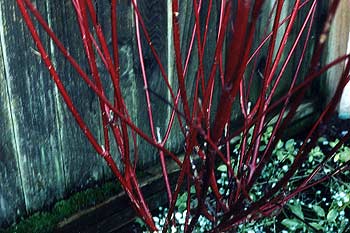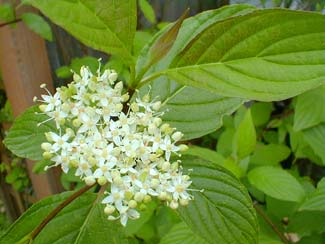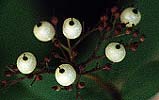
Autumn Leaf Color,
Winter Limb Color,
Spring Blossoms,
& Summer Fruits
of Red Twig Dogwood
"From twig to twig the spider weaves."
-George Meredith,
1828-1909.
1828-1909.
To insure that a garden is beautiful in winter, we try to consider what a plant will be like in each season, & what areas of group plantings might seem dull after leaf-fall & winter die-back of certain perennials. Personally I prefer woody plants with interesting bark textures & I'm not much fascinated by annuals such as gardeners plant for sake of flowers primarily, though Granny Artemis likes bulbs & annuals more than I do & has been educating me to the wonders of bulbs.
Our Red Twig Dogwood (Cornus sericea formerly C. stolonifera) has wonderfully colorful wine-red twigs, beautiful all year round. Sometimes called Red Osier, the color of the twigs varies regionally & by cultivar from coral to bright crimson.
 For yet another interesting winter twig, compare this red-twig dogwood to the red twigs of our Nishiki Willow, which unlike the dogwood is not red except in winter.
For yet another interesting winter twig, compare this red-twig dogwood to the red twigs of our Nishiki Willow, which unlike the dogwood is not red except in winter.As cuttings the twigs of the North American redtwig hold their fabulous color indefinitely, & a vase of slender naked limbs is as appealing as any vase of flowers. Though not demanding to be pruned to thrive, the younger twigs develop the brightest winter color.
For appearance sake or to restrain its size, it can have its density of twigs thinned to encourage new bright growth. Older inner branches are the ones to be trimmed to the bottom. Young outer suckers can be dug up & transplanted with ease.
When not pruned, redtwig dogwood will flower well & berry profusely, but get large & by some assessments leggy (I prefer "large & fountaining"). Spring-pruned specimens have much brighter red young stems come winter (or more intense golden, depending on cultivar), plus a more compact appearance for the spring through autumn foliage, but produce far fewer flowers & berries.
Pruning is not necessary for health, but only to increase youthful limbs with brightest winter color. It can have as much as one-third pruned out of it every other year & probably still berry nicely. If hard pruned entirely or annually, forget berries. If bark is still very red & the shrub hasn't become overgrown & "in the way" with its suckering & fountaining, there's no reason to prune it that year at all. It could just as easily be left to naturalize never pruned at ever, though it'd get awfully big in time.
When pruning to intensify limb color, the thick older inner twigs are the ones that should be cut nearly to the ground. If you want to have good flowering, don't prune out more than one-third of the branches in spring. Also prune the outermost suckers below the soil line if you want to maintain a compact form & encourage branching more from the middle.
It should be done about March or April. If done later in spring, it won't injur the shrub, but it won't look like much in winter, so might as well wait until the following March. Summer's a bad time to do it, & for sure it won't have time to fully develop nice new red limbs for winter. A major pruning can be done in autumn with no negative health impact for the shrub, but then once more you have a stubbly thing for that winter, so might as well wait for March amp& prune just before new growth would begin.
Red-twig dogwood grows in forests from Newfoundland to Alaska & south through the Rockies & into California. It is highly cold-tolerant, disease resistant, with rapid growth, at risk only if soil is insuffuciently moist. Though preferring acidic soil, it does well in all soils. It can be used in basketweaving because it is both pliable & colorful.
 It typically grows six feet or so, but twice that height is not unusual. Its white flowers are extremely tiny & you have to look close to see they're just like the four-petaled flowers of larger dogwoods. They occur in flattened clusters about May, followed by tiny quarter-inch summer fruit. The fruit portrait here at the left is from July when they are snowy white, but on some specimens the fruit gets a steel-grey or lead-color. Ours gets a the second bloom late in July that lasts into August, but without sufficient time in the season for a second round of the white berries. Maximum fruiting occurs on rarely-pruned specimens but maximum twig-color is on often-pruned specimens; plus, to pollinate well, they need to be planted in groups, as a single shrub is not self-fertile.
It typically grows six feet or so, but twice that height is not unusual. Its white flowers are extremely tiny & you have to look close to see they're just like the four-petaled flowers of larger dogwoods. They occur in flattened clusters about May, followed by tiny quarter-inch summer fruit. The fruit portrait here at the left is from July when they are snowy white, but on some specimens the fruit gets a steel-grey or lead-color. Ours gets a the second bloom late in July that lasts into August, but without sufficient time in the season for a second round of the white berries. Maximum fruiting occurs on rarely-pruned specimens but maximum twig-color is on often-pruned specimens; plus, to pollinate well, they need to be planted in groups, as a single shrub is not self-fertile.Judging by ours, the bright green leaves fade quite slowly to autumn yellow. People who have them in climates with more extreme weather report that the leaves get more colorful & red, but ours retains many green leaves to the end of autumn. Most years, the branches aren't totally bare until December.